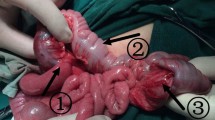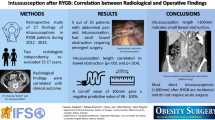Abstract
Background
Intussusception secondary to pathologic lead points (PLPs) is a potential surgical emergency and almost all cases need surgery. The aim of this study was to evaluate the clinical manifestations, physical examinations and surgical outcomes of secondary intussusception (SI) caused by PLPs, as well as to improve the diagnosis and treatment of PLPs in children and infants.
Materials and methods
We retrospectively reviewed the records of 83 children and infants who were diagnosed with intussusception secondary to PLPs in our institution. The ultimate diagnosis was dependent on histopathological findings under a microscope by a pathologist. Patients were divided into a younger group (< 2 years old) and the older group (> 2 years old) according to age. Patient demographics, clinical manifestations, duration of symptoms, auxiliary examinations, and the presence of pathological lead point were recorded.
Results
A total of 83 patients were found with intussusception secondary to PLPs in this study. Patients were aged from 4 days to 14 years, with a mean age of 3.8 years (median 1.5; range 0–14 years). There were 47 cases in the younger group and 36 cases in the older group. The main clinical symptoms were intermittent crying or abdominal pain. PLPs were observed in only ten patients on US (12%). Ten patients underwent enteroscopy examination for further diagnosis, and all the patients had positive findings including seven cases of Peutz–Jeghers syndrome and three cases of benign polyps. Technetium-99 m pertechnetate scans were performed in ten patients and five patients had positive results (50%). Based on the surgical findings, complex/compound is the most common type of intussusception, followed by small intestinal and ileo-colic type. The main types of PLPs were Meckel’s diverticulum (n = 31), duplication cyst (n = 19) and benign polyps (n = 13). Meckel’s diverticulum and intestinal duplication were the most common causes of secondary intussusception among children younger than 2 years, accounting for 81% (38/47) of the cases. The most common causes of secondary intussusception in children older than 2 years were intestinal polyps, Meckel’s diverticulum and Peutz–Jeghers syndrome, accounting for 72% (26/36) of the cases.
Conclusions
The presence of a pathological lead point is more likely in older children. The most common types of intussusception secondary to PLPs are complex/compound and small intestinal. Meckel’s diverticulum and intestinal duplication were the most common causes of secondary intussusception among younger children and Peutz–Jeghers syndrome and intestinal polyps were commonly seen in older children.

Similar content being viewed by others
References
Yao XM, Chen ZL, Shen DL et al (2015) Risk factors for pediatric intussusception complicated by loss of intestine viability in China from June 2009 to May 2014: a retrospective study. Pediatr Surg Int 31(2):163–166
Takahashi T, Miyano G, Kayano H et al (2014) A child with colo-colonic intussusception due to a large colonic polyp: case report and literature review. Afr J Paediatr Surg 11(3):261–263
Wong CW, Jin S, Chen J et al (2016) Predictors for bowel resection and the presence of a pathological lead point for operated childhood intussusception: a multi-center study. J Pediatr Surg 51(12):1998–2000
Somme S, To T, Langer JC (2006) Factors determining the need for operative reduction in children with intussusception: a population-based study. J Pediatr Surg 41:1014–1019
Huang HY, Huang XZ, Han YJ et al (2017) Risk factors associated with intestinal necrosis in children with failed non-surgical reduction for intussusception. Pediatr Surg Int 33(5):575–580
Wong CW, Chan IH, Chung PH et al (2015) Childhood intussusception: 17-year experience at a tertiary referral centre in Hong Kong. Hong Kong Med J 21:518–523
Blakelock RT, Beasley SW (1998) The clinical implications of non-idiopathic intussusception. Pediatr Surg Int 14:163–167
Hsu W-L, Lee H-C, Yeung C-Y et al (2012) Recurrent intussusception: when should surgical intervention be performed? Pediatr Neonatol 53:300–303
Stringer MD, Pablot SM, Brereton RJ (1992) Paediatric intussusception. Br J Surg 79:867–876
Kong MS, Chen CY, Tzen KY et al (1993) Technetium-99 m pertechnetate scan for ectopic gastric mucosa in children with gastrointestinal bleeding. J Formos Med Assoc 92:717–720
Huppertz HI, Soriano-Gabarro´ M, Grimprel E et al (2006) Intussusception among young children in Europe. Pediatr Infect Dis J 25(1 Suppl):S22–S29
Lin Xiao-kun, Xia Qiong-zhang, Huang Xiao-zhong et al (2017) Clinical characteristics of intussusception secondary to pathologic lead points in children: a single-center experience with 65 cases. Pediatr Surg Int 33(7):793–797
Cooke DC, Lewis EC (1960) A Thirty-year survey of acute intussusception in childhood. The Lancet 7165:1359–1364
Bines JE, Ivanoff B, Justice F et al (2004) Clinical case definition for the diagnosis of acute intussusception. J Pediatr Gastroenterol Nutr 39:511–518
Zhang Y, Dong Q, Li SX et al (2016) Clinical and ultrasonographic features of secondary intussusception in children. Eur Radiol 26(12):4329–4338
Daneman A, Alton DJ, Lobo E, Gravett J, Kim P, Ein SH (1998) Patterns of recurrence of intussusception in children: a 17-year review. Pediatr Radiol 28:913–919
Tan HL, Koh YX, Taufik M et al (2018) A Clinical scoring system to predict the clinical sequelae of computed tomography diagnosed intussusception. World J Surg 42(3):682–687
Navarro OM, Daneman A, Chae A (2004) Intussusception: the use of delayed, repeated reduction attempts and the management of intussusceptions due to pathologic lead points in pediatric patients. AJR Am J Roentgenol 182:1169–1176
Grosfeld JL (2005) Intussusception then and now: a historical vignette. J Am Coll Surg 201:830–833
Author information
Authors and Affiliations
Corresponding author
Ethics declarations
Conflict of interest
The authors report no conflicts of interest in this work.
Human rights and animal participants
This article does not contain any studies with human participants or animals performed by any of the authors.
Additional information
Publisher’s Note
Springer Nature remains neutral with regard to jurisdictional claims in published maps and institutional affiliations.
Rights and permissions
About this article
Cite this article
Zhao, L., Feng, S., Wu, P. et al. Clinical characteristics and surgical outcome in children with intussusceptions secondary to pathologic lead points: retrospective study in a single institution. Pediatr Surg Int 35, 807–811 (2019). https://doi.org/10.1007/s00383-019-04471-8
Accepted:
Published:
Issue Date:
DOI: https://doi.org/10.1007/s00383-019-04471-8




